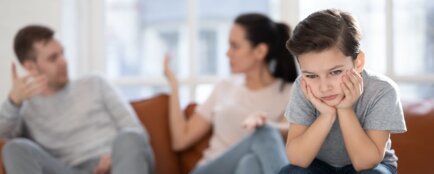What facilities belong to institutional care?
The system of institutional care in the Czech Republic includes different types of facilities, which are specialised according to the needs of the children placed in them.
Children’s Diagnostic Institute (DDU)
A children’s diagnostic institute is the first stop on the journey of a child to be placed in institutional care. A child will usually not stay in a diagnostic institute for more than eight to twelve weeks. As its name implies, this institution is primarily for diagnostic purposes. The experts here observe and work with the child. They assess his physical, psychological and social condition. It is on the basis of this diagnosis that it is then determined which type of institution the child will go to next.
What does this look like in practice? Fourteen-year-old Filip started truanting from school and subsequently ran away from home repeatedly. He had serious conflicts with his parents, who could no longer cope with him. The authorities therefore decided to place Filip in a children’s diagnostic institute, where, on the basis of a diagnosis, experts concluded that he needed intensive care in an educational institution.
Children’s homes
Children’s homes are a child’s alternative, often only known, home. Children who do not need any special educational measures are placed in children’s homes. However, they cannot stay with their parents or grandparents for various reasons.
Children’s homes provide children with education, fill their free time with various activities and, last but not least, prepare them for independent life when they have to leave the home one day.
Are you solving a similar problem?
Are you fighting for your child?
Has the court ordered your offspring to be institutionalized and you disagree? Do you feel that the law is on your side, but no one is listening to you? Contact our law firm and tell us your problem. We will help you find a solution.
I'm interested
- When you order, you know what you will get and how much it will cost.
- We handle everything online or in person at one of our 6 offices.
- We handle 8 out of 10 requests within 2 working days.
- We have specialists for every field of law.
Educational institutes
A reformatory is what is popularly known as a reformatory. Children who have serious educational problems end up in reformatories. These are usually individuals who have broken the law or who have been rejecting authority for a long time, for example. There are also specific institutions of this type, such as educational institutions for girls, where children are placed according to their gender.
Reformatories are often labelled as reformatories or prisons for children. While these terms are emotive, they are also unfair labels. They are not for punishment, but for support.
What does this look like in practice? Fifteen-year-old Carolina was repeatedly caught running away from home and using addictive substances. After several unsuccessful attempts to return to her family, she ended up in an educational institution for girls, where professionals help her to stabilise her behaviour.
Tip for article
Tip: According to a report by the Czech Ministry of Labour and Social Affairs, the number of children at risk of neglect who have been removed from their families and placed in foster care or institutional care has increased significantly (by 6 000) over the past 15 years.
How the decision-making process for placement in institutional care is carried out
The fact that a child will go to an institution under institutional care is not a decision that is made on the spur of the moment. It must first be approved by the court, often on the proposal of the children’s social protection authorities(OSPOD). The basis is the Children’s Social Protection Act, but the Civil Code and other legislative norms also play a role.
- The OSPOD first assesses the situation in the family and examines how the state could improve the situation through available organisations and institutions. It may suggest, for example, domestic assistance, financial support or therapy, either for the child or for the parents.
- If this support fails and the situation does not improve, the OSPOD will petition the court to place the child in institutional care.
- The court considers all the evidence and alternatives before deciding to place the child in an institution.
The parents of the child in question have the right to be part of the proceedings, to inspect the files and to appeal the decision. Even if the child is placed in a children’s diagnostic institute or other facility, they do not automatically lose their parental rights.
The court may decide to place the child in institutional care for a maximum of 3 years. It may extend this period repeatedly if the reasons for ordering institutional care continue. Every 6 months the court must review whether the reasons still apply or whether there is no possibility of alternative family care.
What are the effects of institutional care on children?
Nothing is black and white. Neither are institutional care, educators and other professionals who work in each facility. It is therefore difficult to generalise and judge what is bad and what is good. Just as every child and his or her psyche is different. Nevertheless, based on long-term experience and research, some conclusions can be drawn.
Long-term institutional care therefore has a variety of effects on children. Several factors need to be taken into account, such as the age of the child, the child’s personal experience of his or her previous family or the quality of care in a particular institution.
Among the positive effects of institutional care, we can certainly mention the stability and security that children often lack in their original family environment. However, these aspects are only basic pillars that should be taken for granted and not the main benefit. Children are also given the opportunity to attend therapy or work on their education – but the question remains as to how individual and effective this approach really is. Institutional care often resembles a systemic band-aid for much deeper wounds that require not only professional intervention but also consistent and long-term support in everyday life that institutional settings often fail to provide adequately.
And then, of course, there are the negative consequences. One of them, for example, is stigmatisation. Children who have been through an educational institution or children’s home often face prejudice. When they are placed in institutional care, they also have limited contact with their family. Although professionals often do their best, the emotional attachment to the parents is often so broken that a healthy relationship between parent and child cannot be established.
Are there any alternatives to institutional education?
Institutional care should ideally always be the last resort. The state and the OSPOD are looking for different alternatives that can offer the child security and a family background. Work is currently underway to end institutional care for the youngest children. The aim is to ensure that children under the age of three are not placed in children’s homes.
Foster care, for example, may be one option. Foster parents have both the right and the duty to care for the child entrusted to them. However, unlike adoption, they do not have parental responsibility or a maintenance obligation towards the child. Ideally, the child will be placed with a family where he or she will experience stability and emotional support.
The support of the biological family is also important. Many families find themselves in a crisis that is only temporary. Financial help, professional counselling or assistance in the home can sometimes prevent the child from having to leave the family altogether.
Then there are also crisis centres that offer temporary help to children and parents. They serve, for example, victims of domestic violence or families in acute distress.
What is the future of institutional education in the Czech Republic?
In the Czech Republic, the concept of deinstitutionalisation, i.e. replacing large institutions with smaller facilities or family-type care, is gaining ground. This approach is inspired by foreign models, for example from Scandinavia, where families receive intensive support before the situation escalates. Similar approaches have proven successful in some SOS Children’s Villages in the Czech Republic, where children grow up in smaller groups with foster parents.
Residential education is an important tool to protect children who have no other option. Although it is often associated with negative emotions, it can be the key to a better future. However, prevention and support for families are always a better way than placing a child in an institution.
If you are dealing with a similar situation, do not hesitate to contact a lawyer, social workers or therapists. You can give your child a chance for a happy life outside of an institution.
Summary
Residential care involves caring for children who cannot stay with their families, whether because of neglect, abuse, or serious family problems. This includes children’s homes, diagnostic institutions and educational institutions (popularly known as reformatories). Diagnostic institutions are used to assess children’s needs, children’s homes provide a stable environment and preparation for independent living, while reformatories help children with serious educational problems. Prevention, support for families and finding alternatives such as foster care are key so that children can grow up in as natural an environment as possible.




